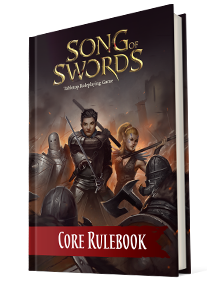 Two weeks ago, I spoke with Zachary Irwin and James Lacombe of Opaque Industries about their upcoming tabletop fantasy roleplaying game Song of Swords, which is now being funded on Kickstarter. In Part I of the interview, we discussed the influence of historical martial arts on the game’s combat system. Part II concerned the influence of continental European history and mythology on Song of Sword’s distinctive brand of fantasy. In the final part of our conversation, we turned towards the societal role of pen and paper RPGs, including Song of Swords, and discussed some of the cast of non-player characters one might encounter on a quest through the Tattered Realms.
Two weeks ago, I spoke with Zachary Irwin and James Lacombe of Opaque Industries about their upcoming tabletop fantasy roleplaying game Song of Swords, which is now being funded on Kickstarter. In Part I of the interview, we discussed the influence of historical martial arts on the game’s combat system. Part II concerned the influence of continental European history and mythology on Song of Sword’s distinctive brand of fantasy. In the final part of our conversation, we turned towards the societal role of pen and paper RPGs, including Song of Swords, and discussed some of the cast of non-player characters one might encounter on a quest through the Tattered Realms.
The following transcript has been edited for length and clarity, with light edits for accuracy.
Q: You mentioned earlier that you see [the game] as being mostly entertainment. But given the attention you paid to introducing historical worldviews—historical anxieties, as it were—to the fabric of the setting, do you see roleplaying games as just being entertainment? Or do you also see it as something in which people try to work out cultural anxieties they might still have?
Zach: I think, generally, every campaign’s going to be different. Every session’s going to be different. Every group’s going to be different. I feel like we’ve given people the tools to tell the story they really want to tell in a setting that is rich culturally and politically. So I think it can definitely support that kind of exploration for groups, while not forcing it down anyone’s throats or anything like that. At least, that’s my answer.
James: I don’t really know. It’s kind of a hard question to ask, or a hard question to answer. But, in general I think the politicization of entertainment is a bad thing. Or, at least, at best a neutral thing. But I definitely think you’re right, in that people do reflexively. I should rather say that the politicization of something simply for the sake of doing so, or to try to push an agenda on people, generally is not something that is desirable. Certainly it’s not something I have any interest in doing.
Zach: It’s not something we’ve set out to do.
James: It is a natural impulse of people, if they have sort of a pathos, or a historical impulse they feel the need to address because of something in their cultural, or racial, or national past… You know, they just want to work something out in that way, as you said. There’s nothing wrong with that. But it’s a little bit weird when you see [that built into] tabletop games in particular, because it’s such a group-centered milieu. Everything really relies on your GM and on your players. Not so much of it is supposed to come from the makers of the game. It’s very weird to see the trend of politically or socially conscious tabletop games [that’s] going around. Players don’t like that stuff. If you go on the internet… I won’t name any names, but there are a lot of games out there that are trying their bestest to make a political or social message. Everyone hates it, because it just feels so preachy and kind of whingey, you know? Someone always gets annoyed by it. So what’s the point?
Q: I’m concurring with what you say there when it comes to roleplaying games, since it does have to come out of the… From my experience DMing, [I can say that] you really need to create the game not just from what the DM wants, but from a collaboration between the DM and the players, so you are able to bring out what’s there. You can’t really force people to address specific issues. Of course, the values of the group will determine how you play. But, it’s, again, as I say, it’s the group that’s deciding that, not necessarily the people who are making the setting. As long as you’re not doing something like D&D 2.0 did, and gave everyone an appearance stat, and women had higher appearance than men did.
[chuckling]
James: I forgot about that.
Zach: Really, in the end, we’re all here for fun. And we’re trying to provide an avenue for fun for people. That’s always going to be our focus.

James: We’re definitely, definitely not promoting a Serbian, ultra-nationalist agenda.
[laughter]
Zach: No, not at all!
James: Any claims to the contrary are lies.
Q: It does seem that in times like ours—let me know if you agree with this or not—everything becomes even more politicized than it already is. It seems to me, as a writer, there is always a political dimension to everything, because when you have people in power they always want to restrict ideas in a way that favors them. So… as I’m coming from a science fiction perspective, I mean there’s always some sort of social commentary in [writing]. It’s completely different when it’s tabletop games, because the whole point is to get out of the way and let the players create their own thing. But it’s different with writing, in which you need to have [a message]. Though, needless to say, you don’t want to push it on people, you [still] need to be able to say it. But it does seem that when you have times in which there are tensions like the ones we have today, suddenly everything seems like a message.
Zach: Well, actually I think it’s kind of the opposite. I think people are wanting an escape, especially when they go to games like this. That’s just tabletop games as a whole. You know, you’re literally transporting to a completely different realm of reality, and for us that’s also taking a big ol’ step into the past.
James: I think there are elements of both that are correct. A lot of people are looking to politicize, a lot of people are looking to get a message out. A lot of people also want to just say: “Okay, I’ve had enough of it for this week. I just want to play some games.” And there’s room for both of that. There’s room for both of those here, in our very large hobby. Really, in the medium in general, there is room for escapism and for commentary. We’ve just generally chosen to make this about escapism. And maybe a little bit about self-reflection.
Zach: Yeah.
James: But self-reflection isn’t the same thing as commentary. I don’t want to tell anyone what to believe. I would like it if people analyzed themselves a little bit more. And in a game where the whole point is that you decide upon the motives of your character and follow them—then maybe that’s a good venue to do that. But again, it relies not on me, and not on you or not on Zach or anyone else except the person playing. So the power is really all in the player’s hands, then. It is as introspective of an experience as they want it to be. It’s the way it’s supposed to be.
Q: Got it. I think we’re coming up towards the end here, but before we get to our final thoughts, I understand you have a really interesting cast of NPCs and important characters. If you could just run me through some of the most notable ones…
Zach: Well, the absolute best character is called Sir Willhelm the Strong. [laughs] No no no, James, why don’t you talk about Sarah Gizka (sp?) please? She’s the one who’s become our mascot.
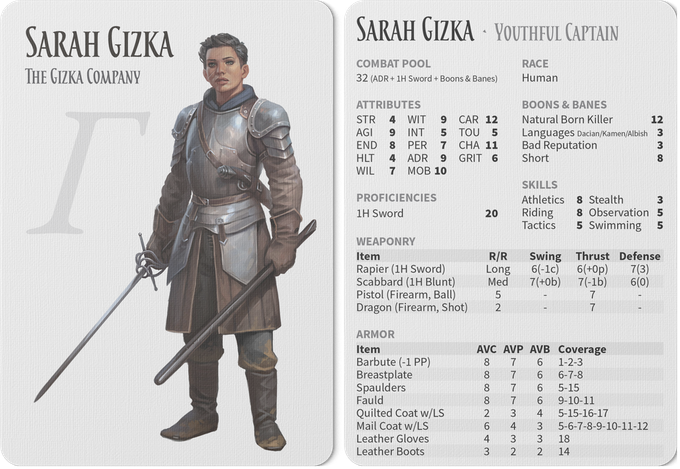
James: Oh yeah. So Sarah Gizka became the mascot of our game, and there’s a very long story behind this. In the early days, we were running small, miniature campaign battles on 4chan. And the character in one of these fights was called Sarah Gizka. At the time, it was a historical thing. She was a five-foot tall Armenian woman who was assassinating a cardinal in some Italian city. Throughout the various incarnations of this game that character has become increasingly central and idiosyncratic to the game, to the point which we’ve now looped her over to the realm of fantasy. Now she’s an established character in one of the countries in the fantasy setting. She’s leaped forward twenty—sorry, ten years. She’s now in her late twenties, instead of a 16-year-old young assassin type. But Sarah Gizka… for some reason, the fans just really liked this character. There’s a lot of jokes, there’s a lot of memes going around surrounding her. She’s also the subject of our first starting army deck, which is cool.
Q: I see. So you have stats for her, then?
Zach: Yes.
James: We have stats for her, and… this was intentional: we have stats for her when she was sixteen. It was her as a youthful captain. You know, as they say: if you stat it, they’ll kill it. So we statted her out as she was ten years ago, and she’s already very near the top of the power that’s possible to achieve in this game.
Q: I see. So what if you kill her when she’s sixteen? Is she only a legend, then, because she comes back from the dead, like many other characters in this setting seem to do?
James: Maybe. It’s possible. They say the legend will never die, so that probably means she can’t die. But you can do that and make it like a time paradox.
Q: I’m looking at her design right here, and this didn’t occur to me before, but I just have to mention it now. I know we’re getting back into political territory here, but I would like to commend you on giving her realistic armor.
[chuckling]
Q: She does not have have boob-plate at all!
James: We took that very seriously.
Zach: Yes. The [closest thing to] tit-plate you’ll find in our game is in King’s rock-hard abs.
[laughter]
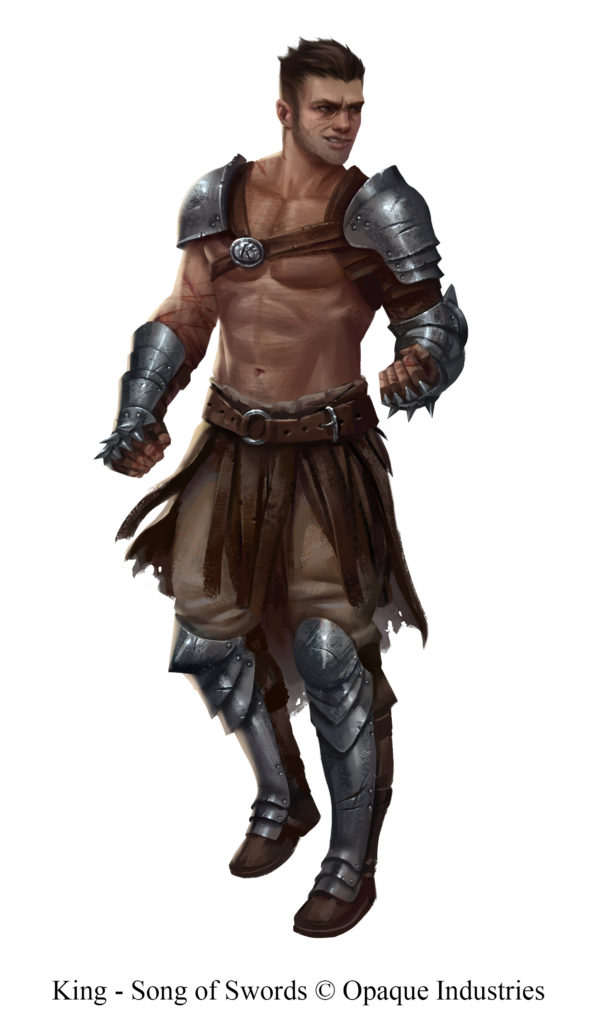
James: That’s true.
[more laughter]
James: I’m not going to say… we didn’t do this to be, like, politically correct or whatever. Nothing like that.
Q: Naturally.
James: We did it because we like realism.
Q: Yeah, exactly.
James: And also, armor looks cool, you know? Armor looks really cool. It’s, frankly, better-looking than these ridiculous fantasy armors you see on some fantasy characters that look like bikinis. Form is function. That’s how I like to think about it.
Zach: If our title character is a five-foot-tall, gender-fluid, dark-skinned woman, then we’re [still] gonna put her in realistic armor.
Q: Naturally, naturally.
James: Zach, you’re killing all of my street cred on the chans.
[laughter]
Zach: It’s too late, man! You’re dead!
Q: This actually reminds me a bit of part of what was motivating me when I was writing my novel. It features, of course, a female protagonist in an alternate version of Renaissance Italy. One of the driving forces behind my making the character is that I wanted to portray a character you could actually believe as being a scientist and a swashbuckler. It seemed to me, especially, if you take a look at the visuals, when you see female characters in media, people try to make them… it’s like they’re trying to… I don’t know exactly how to put it. But you often have people who you don’t believe can actually accomplish certain feats of strength or skill doing them. And… it does take you out of it, a little bit. I like the approach you have here because she’s obviously a warrior. And as you, say, it’s not politically correct.
James: She looks a little bit brutish. This is a person who fights for a living. She’s wearing the armor, and she doesn’t have particularly long hair. It’s actually kinda short. They could grab that. And then you die. Being dead is bad.
Q: So she’s she’s become your mascot. What exactly got her to that point?
James: It’s complicated. When going back to sort of the original fights—we called them “fechts”—they’d run basically a combat, with a bit of narrative on the boards, following along with the action that’s being done. It was a long tradition that goes back to 2011 or something. Her fight was very popular. It stuck in people’s minds, you know. So when we formed our company and started announcing “Hey, we’re making Song of Swords,” and we revealed ourselves to be following the legacy of these fights, and one of these characters was Sarah Gizka. People knew who that was. They were like “Oh, we remember Gizka. She was the person who threw that lady off the walls of Rome, right?”
[laughter]
James: Which did happen. And so the legend grew. Then we started getting fanart of her, and we were like “Okay, well, we might as well integrate her into the setting, since everyone knows who she is already.” We made her a little older, so it didn’t seem like PCs would be competing with her for the spotlight. She’s sort of… not retired, but moved on to being a politician.
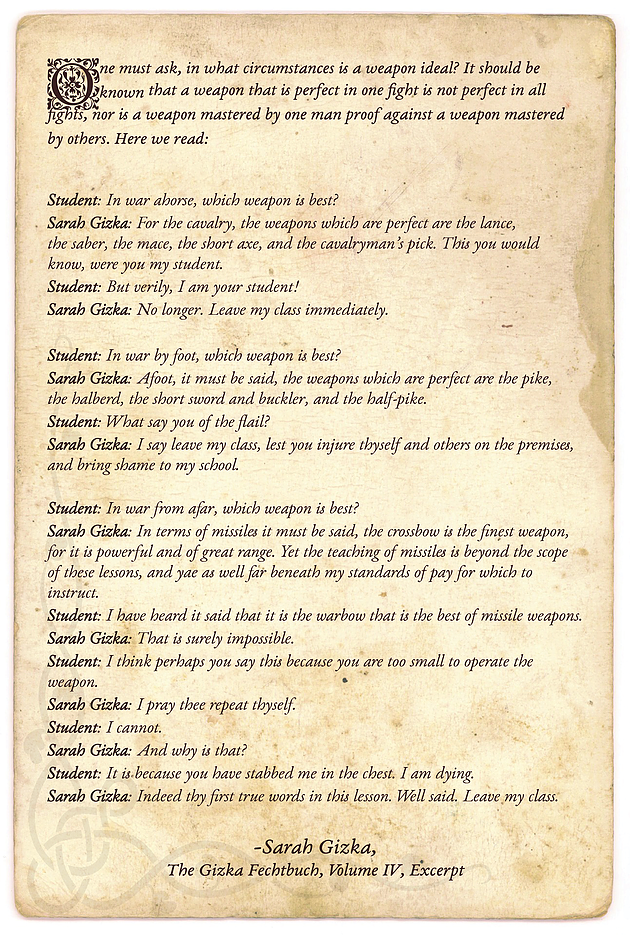
Zach: A Great Captain.
Q: I see.
James: Yeah. She works for the government. She sold out.
[laughter]
Q: Like everyone does, or so they say.
Zach: They try to get her to teach now.
James: Oh yeah.
Q: And then, from what I hear, she stabs them.
Zach: She stabbed one of them.
[laughter]
James: “I pray thee repeat thyself?”
[laughter]
Zach: “I cannot.”
Q: Any more characters you want to go over?
Zach: I can run through the ones we’ve chosen to show on the Kickstarter. The first one is the character I used to play, but he’s been adapted into the setting a lot more heavily. That’s Sir Wilhelm the Strong. He started out as kind of a typical gallant knight, and people used to make fun of me because I always played knights in over their heads. So this one got taken [and] expanded, [and] he is now an undead knight being controlled by a Karthacki witch. And that’s sort of where…
James: He got in over his head.
Zach: He got in over his head. And the metal guy, the giant, is Kal‘Ceska. I think James can tell you a little better about him.
James: Oh, um. Ceska is from Karthack, where they worship the moon goddess. It’s sort of the mystic East of the setting, so to speak. They have a different religion from everyone in the West, they worship their moon-goddess, they’re very culturally different. Kal’Ceska…
Q: Sorry to interrupt, but by “mystic east” do you mean the Far East, the Middle East, the Near East…
James: The Middle East. It’s sort of an amalgamation of Sassanid Persia and the Akkadian Empire.
Zach: A little India, right?
James: There’s a little bit of India in there, yes. Mostly in the East some of the weapon design… urumis and katars.
Zach: He was Taylor’s character, actually, but he’s been larely adapted into the setting now. He’s a big meanie. He cut off both the arms of one of my characters once actually. That happened.
Q: So you were saying he lives in…
James: He lives in Karthack, in sort of the east. He’s another character who’s prominent in the lore. He’s the Warden of the North, or of the East—one of the directions. But he’s a big general, and a philosopher in their society. He wrote a bunch of papers and treatises and stuff. So you see the idea of this huge, hulking guy with a giant axe being an intellectual. So he writes a bunch of treatises on theology and stuff like that. And poetry, but his wife hates him, so his poetry is always unappreciated.
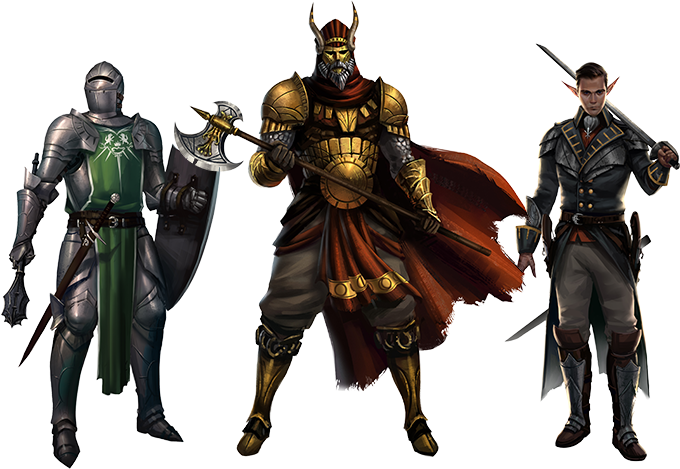
Zach: And the “Kal” in his name is a title, actually. Finally, there is James’s [character], Rade Sark.
James: That was Taylor’s decision to leave him to me, but I guess it makes sense. Rade is a Zell.
Zach: A Zell is an elf.
James: Yeah. Zells are one of the kinds of Din, or elves. But they’re the boat guys. Zells dwell on the ocean and they have that communal relationship with the sea and their ships. As long as they’re on their ships, they share a sort of hive mind with the rest of their crews. Generally they’re kind of peaceful, nice guys. But Rade Sark is more of a villain. He decided he really hates humans, because humans keep coming on to his ocean, and it pisses him off, so he organized a fleet called… the “Fleet of the Sea of somethings…” [Editor’s Note: The Black Fleet of the Western Sea is the name.] He founded a fleet out of eleven tribes and basically dedicated it to throwing all humans off of the ocean forever. He just wants us humans to go back onto the land, where they belong, and his people can own the ocean.
Q: He’s like a cranky son of Poseidon.
James: Yeah, basically. He’s kind of a bad guy, but he’s sort of a sympathetic character, because his background makes some of his bitterness against humans understandable. He had to work for humans when he was younger, because he was born in the England analogue (if it were colonized by Slavs instead of Normans, basically). Good times with that. It’s called the Krajina. He was enslaved by them for a long time [as] part of their navy, and when he broke free he had a burning hatred for humans that never went away. So he organized these fleets to try to destroy humanity, because he’s mad that he was abused as a child, or as a young man. He’s the Zell perspective. It’s tricky to make Zells into bad guys, because you think they’d be super chill, but obviously not all of them are.
Q: Just as with anybody, anytime you have a certain cultural value, you have somebody who can subvert it, or the value itself might have a dark side that can manifest in the right situations.
James: Yeah. It’s not far of a jump from living on the sea to believing that the sea belongs to you.
Q: We’re about at the end here. Any final thoughts?
Zach: I think that’s about it for us. Thank you very much for your time.
Q: Thank you very much! It’s been a pleasure speaking about this.
Song of Swords is being funded on Kickstarter. More information on the game can be found on the Kickstarter page, and the crowdfunding campaign ends on March 18th.

Zachary Irwin, also known as, Claymore, is President and co-founder of Opaque Industries. A former Chaosium employee, he boasts five years of experience in the game industry and collaborated with James Lacombe on the Song of Swords ruleset.
James Lacombe, known online as Jimmy Rome, is the lead game designer for Song of Swords and co-founder of Opaque Industries. He is the creative mind behind the setting of Vosca, and has refined the game through numerous online playtests.
Taylor Davis, or “Bones” as he is known online, was not able to join us, but is no less an important part of the Song of Swords team. A mobile gaming professional, he serves as art director and project manager, shaping the look of the game through collaboration with the art and layout teams.
